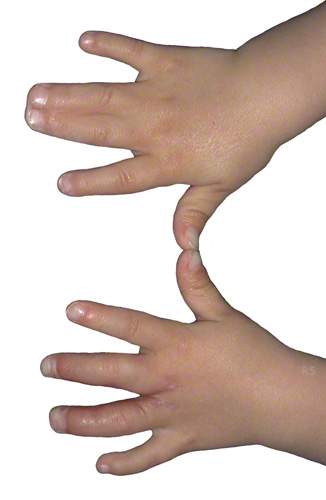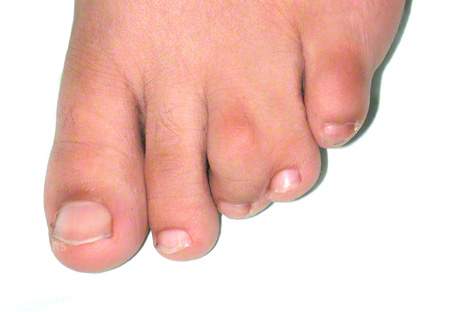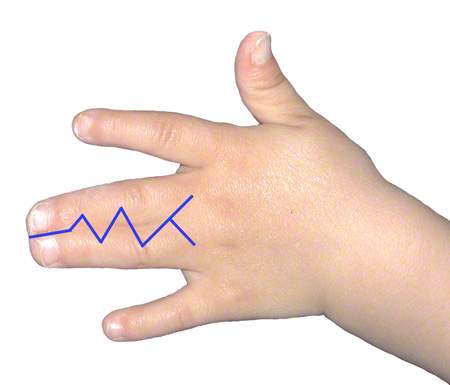
What is syndactyly?
Syndactyly does not refer to fingers that have grown together, but to fingers that have remained together during embryonic development. The disease is caused by a lack of finger separation at the hand bud of the embryo. Two or more fingers can be affected. Syndactyly can mean only a skin connection, but also a bony connection. If there is a bony connection, the fingernails are often also connected to each other. If very rarely all the fingers are joined together like a spoon, this is referred to as a spoon hand.
Syndactyly can occur individually or as part of syndromes, i.e. diseases that are associated with various malformations. A combination with other malformations is also possible. Accordingly, syndactyly is often associated with Apert syndrome, Carpenter syndrome, polydactyly (too many fingers), split hand, lacing ring syndrome, etc.
Syndactyly also occurs in the foot. The connection here is usually between the 2nd and 3rd toe.
Image: Syndactyly on the foot between the 3rd and 4th toe.

Facts
- Syndactyly is inherited in about 20-40% of cases.
- In the literature, the frequency is usually given as one syndactyly per 2000-2500 births in Caucasians. This makes it the most common malformation of the hand.
- Men are affected about twice as often as women.
- In half of the cases, the 3rd interfinger fold (between the ring finger and middle finger) is affected by syndactyly.
When should syndactyly be operated on?
The operation for syndactyly depends on the extent of the deformity. The extent of the bone involvement can be shown on an X-ray. If only a small part of the skin is affected by the syndactyly, in the sense of webbed toes, surgery is generally not necessary. On the foot, separation of the 2nd-5th toe is not functionally necessary, but can be performed on request.
In terms of the time frame, surgery is usually recommended between six months and two years of age for fingers of unequal length. If you wait too long, deformities can remain in the joints and bones. If the fingers are the same length, surgery can be performed between the ages of 2 and 4. However, the recommendations vary.
How is the operation performed?
Syndactyly surgery is performed under general anesthesia, as the patients are generally in early childhood. An inpatient stay may be necessary depending on the extent of the operation.
In the case of syndactyly without bone involvement, the skin is incised between the fingers in a zigzag shape (so-called Z-plasty or W-plasty). The underlying soft tissue structures are cut through, protecting nerves, vessels and tendons. This creates a skin defect that must be covered with a skin graft from another part of the body (e.g. groin area).
The zigzag-shaped skin incision is intended to prevent the contraction of the scar from restricting movement. In the case of syndactyly with bone involvement, the affected bones must also be separated.
As these operations can lead to a reduction in blood flow, more than 2 fingers should never be separated in one session. The next operation is recommended after 3-6 months at the earliest if several fingers are affected. Some surgeons also perform a bilateral operation in one session in the case of bilateral syndactyly, others proceed in two stages.
What to look out for after syndactyly surgery?
For young syndactyly patients, an adequate, well-fixed dressing is very important for complication-free wound healing. Adhesive bandages that are wrapped over fatty gauze and absorbent cotton are well suited so that the young patients cannot loosen the bandage. The stitches are removed after 10-14 days. A short anesthetic is often necessary for this, as this is otherwise not tolerated. The healing of the transplants can be assessed after just 4-5 days.
Once the wound has healed, adequate exercise therapy is indicated. Scar care with ointments and massage will make the scars softer and less noticeable more quickly.


